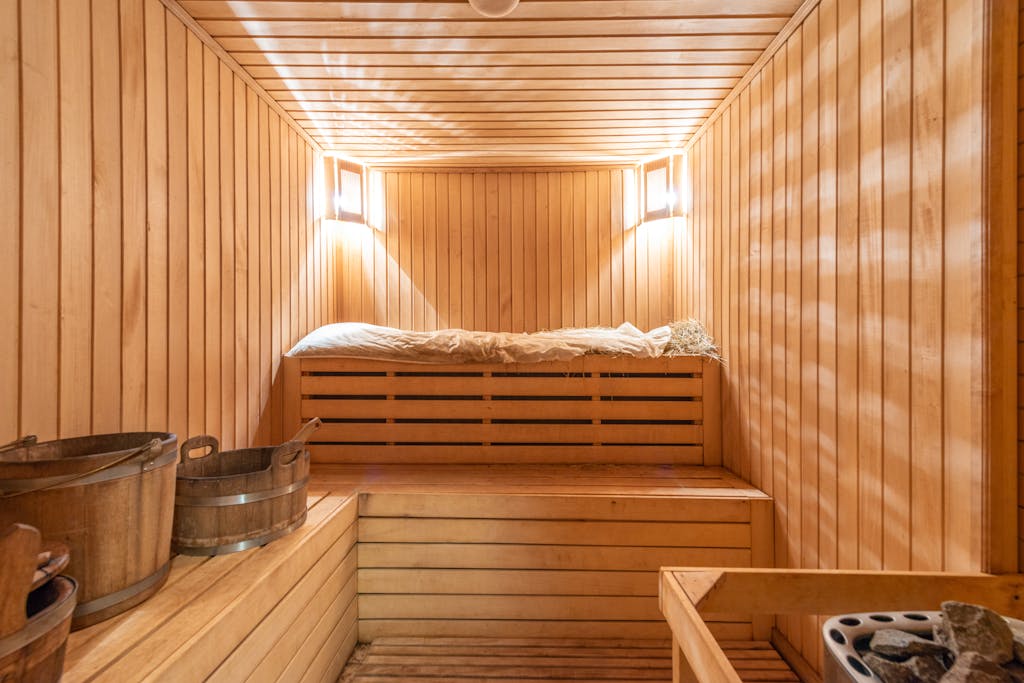FREE SHIPPING OVER $50
Best Sauna Temperature and Time for your Health
Heat therapy, especially in the form of a sauna, has been used for centuries for its health benefits. But to unlock these benefits, it’s crucial to understand the optimal sauna temperature. Too hot, and it could be uncomfortable. Too cold, and you might not reap the full benefits. In this blog post, we will discuss the best sauna temperature and time for your health.
Key Takeaways:
Understanding Sauna Temperature

The temperature in a sauna can vary greatly depending on the type of sauna. In a traditional Finnish sauna, temperatures often range from 150 to 195 degrees Fahrenheit (65 to 90 degrees Celsius). However, in an infrared sauna, the temperature is usually much lower – often between 120 and 140 degrees Fahrenheit (50 and 60 degrees Celsius).
But it’s not just about the temperature. The duration of your sauna session – the sauna temperature and time – also plays a crucial role in the health benefits you can achieve.
Sauna Temperature and Time
The ideal sauna session length can vary depending on your comfort level and experience with saunas. For beginners, starting with shorter sessions of around 10 to 15 minutes is recommended. As you become more accustomed to the heat, you can gradually increase your session length. Most sauna enthusiasts aim for sessions of around 20 to 30 minutes.
Remember, the goal is not to endure an uncomfortably long or hot sauna session. Instead, it’s about finding the best sauna temperature and time that allows you to relax and enjoy the experience.
Health Benefits at the Right Temperature
When used correctly, saunas can offer a wealth of health benefits. The key to unlocking these benefits lies in finding the optimal sauna temperature and time. Here’s a more detailed look at the health benefits you can expect from regular sauna use:
- Improved Cardiovascular Health: Regular sauna use can help improve cardiovascular health by increasing circulation, reducing blood pressure, and enhancing heart function. The heat from the sauna causes your heart rate to increase, which can help improve cardiovascular fitness over time.
- Better Skin Health: The heat and humidity in a sauna can help open up pores and increase sweating, which can help cleanse the skin and improve its appearance. Regular sauna use can lead to clearer, healthier-looking skin.
- Enhanced Mood: Spending time in a sauna can also have a positive impact on your mood. The heat can help reduce stress and promote relaxation, leading to an overall improvement in mood and well-being.
- Relief from Symptoms of Arthritis: The heat from a sauna can help soothe stiff joints and reduce pain associated with arthritis. Many people with arthritis find that regular sauna use helps improve their symptoms and enhances their quality of life.
- Detoxification: Saunas can help your body detoxify by promoting sweating, which can help remove toxins from the body. This can lead to improved health and well-being.
The Risks of Misjudged Sauna Temperature and Time
While the benefits of sauna use are plentiful, it’s crucial to understand that improper use can lead to unwanted side effects. Misjudging the sauna temperature and time can potentially lead to discomfort and health risks.
- Overheating: Spending too much time in a sauna or setting the temperature too high can lead to overheating. Symptoms can include dizziness, nausea, or even fainting.
- Dehydration: Saunas can cause significant fluid loss through sweating. Without proper hydration, this can lead to dehydration, which can be serious if not addressed promptly.
- Heat Exhaustion or Heat Stroke: In extreme cases, prolonged exposure to high temperatures without adequate hydration can lead to heat exhaustion or heat stroke, both of which are serious medical conditions.
- Aggravation of Health Conditions: Certain health conditions, such as heart disease or low blood pressure, can be aggravated by the high temperatures in a sauna. Always consult with a healthcare professional if you have underlying health conditions.
Remember, the key to a beneficial and safe sauna experience is to find your personal optimal balance of sauna temperature and time. Always listen to your body and step out if you start feeling uncomfortable. Hydrate well before and after your sauna session, and give your body time to cool down afterwards.
Finding Your Optimal Sauna Temperature
The optimal sauna temperature is not a one-size-fits-all concept. It can depend on various factors which include:
- Personal Preference: The ideal sauna temperature varies from person to person. While 150-175°F is commonly preferred, seasoned users may opt for up to 195°F for a more intense experience.
- Sauna Type: Traditional saunas with wood or electric heaters typically range from 140-200°F. Infrared saunas, however, operate at lower temperatures of 100-125°F, directly warming the body.
- Humidity Factor: The Rule of 200 suggests that the sum of the sauna’s temperature and humidity should equal 200 for optimal comfort. For example, at 160°F, the humidity would be set to 40%.
- Health Considerations: Regular sessions at approximately 174°F have been linked to improved health and longevity. It’s crucial to stay hydrated and avoid heavy meals before sauna use to prevent discomfort.
Conclusion
Finding the best sauna temperature and time for your health doesn’t have to be complicated. By understanding the impact of temperature and session length on your sauna experience, you can optimize your sauna use for maximum health benefits.
Remember, every individual is unique. What works for one person might not work for another. So, don’t be afraid to experiment with different temperatures and session lengths to find what works best for you.
Related Articles
- Fulvic Acid Soak: Recipe, Benefits, and Detox Guide
- Honest DRMTLGY Review: Read Before You Buy
- Cymbalta (Duloxetine) Side Effects and Withdrawal: A Comprehensive Guide
- Brain fog: Causes, Symptoms and Medications
- Bee Pollen: A Natural Energy and Immune System Booster
- Fulvic Acid Unveiled: Unlocking the Fountain of Youth Naturally!
- Alpha-Lipoic Acid and Neuropathy: A Comprehensive Guide to Healing
- Celsius Energy Drinks and Drug Tests: Reasons for False Positives







